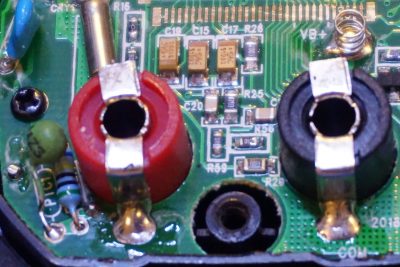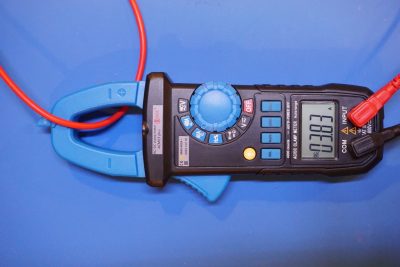I recently purchased a BSide ACM03 Plus clamp meter so that I could do some high current measurements for my tab welder project. This meter can be bought on eBay for around $25, which makes it one of the cheapest Hall effect clamp meters on the market that is capable of measuring both AC and DC current.
Since this is such a cheap meter, I wasn’t expecting much. But it actually feels really sturdy in hand and the construction looks reasonably solid, which is certainly a good start. It came with a nice little black pouch inside a non-descriptive cardboard box. It even includes a decent product manual.
The supplied probes do feel a bit cheap, but are actually much better than some of the probes supplied with better known brand meters (I won’t mention names here). Although the meter is listed as CAT III rated, I would take it with a grain of salt as we know how the advertisement on these cheap products can sometimes bend the truth. That said, for CAT II operations it should have no problem. Using this clamp meter to measure current should be very safe as clamp meters do not require physical contact with the live circuit.
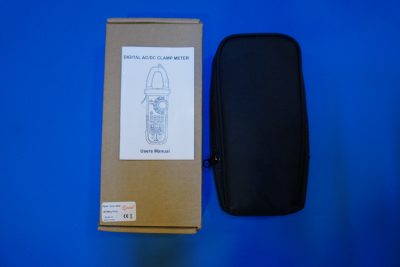
|
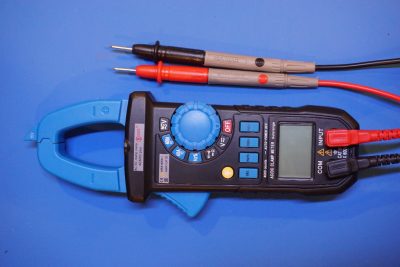
|
This meter’s display quality is quite good and the viewing angle is also excellent. It seems that those Chinese companies have gotten the LCD manufacturing process down pat as even on the cheapest meters the LCDs are usually of excellent quality. The backlight quality is equally good. The white backlight stays on for 30 seconds according to the manual, which is sufficient in practically all situations.
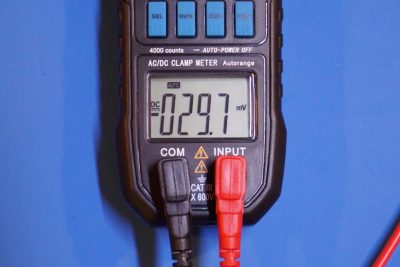
|
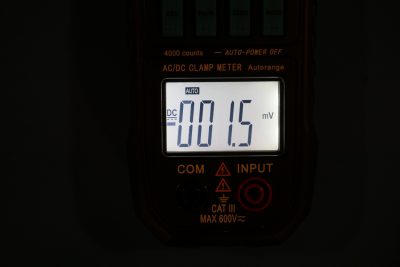
|
The case of the meter is held together by three self-tapping screws. The battery compartment can be opened separately by loosening the screw on the battery cover. ACM03 uses three AAA batteries instead of a 9V battery. I wish more meters take this approach as AAA batteries are much cheaper and typically have much higher capacities which translate into much longer operation time.
Like most cheap meters, the ACM03 uses a chip-on-board (COB) design. The circuit board layout is relatively clean although you do see a jumper wire across the board. This jumper wire seemed to be an afterthought as there’s no footprint for it and the wire is soldered directly onto the lead of the transistor. Besides this oddity everything else looks quite neat. Given the cheap price of the meter, the construction is actually surprisingly good.
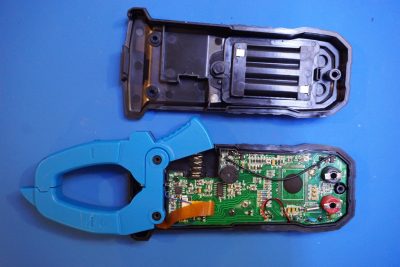
|
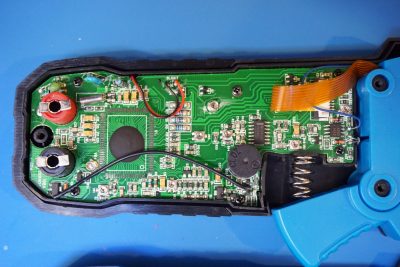 |
The clamp portion feels a bit stiff and requires quite a bit of force to operate, but it feels secure and nothing short of quality.
One of the reasons you shouldn’t trust the CAT ratings printed on the case blindly becomes evident if you take a look at the inputs. There are no MOVs for transient protection which is almost ubiquitous in most brand-name meters for the same CAT rating. There is only a small PTC in the positive path which provides limited protection.
Aside from the fact that the meter lacks adequate input protection, it also lacks high voltage cutout and sufficient trace spacing, but it should be sufficient for household mains measurement especially for the 120V circuit in North America. The case does sport a grooved blast shield along the edges which reduces the likelihood of exploding in case something goes drastically wrong.
In the picture below, you can see that the input jacks are soldered onto the circuit board one side only and repeated insertion and removal of the plugs could result in the failure of the solder joints. But for a clamp meter its specialty is for measuring current and thus I don’t particularly mind this.
One benefit of a Hall sensor based clamp meter is that it can be used to measure either AC or DC current. And I like the fact that there is a 40A range in addition to the 400A range as it gives enough resolution for measuring circuitry that consumes less than an Amp. And the 400A range should be enough for most measurements. Unfortunately, as you might have observed from my spot welder video, 400A is not enough for measuring the secondary current through the transformer and from the current measurement on the primary side the estimated current through the secondary is more than one thousand Amps.
Like most cheap meters, this meter is not a true RMS meter. Thus the current reading is only going to be accurate if the load is resistive. If you are primary interested in measuring AC current through inductive load (e.g. motors) or the input current through switching power supplies, you probably want to invest in a more expensive true RMS meter.
If you are planing to use this meter as your everyday meter, you will likely to be disappointed. While the voltage measurements are accurate and the speed for both the AC and DC range is fine (roughly 2 to 3 updates per second), the resistance and the capacitance measurements will likely irritate you. The resistance auto-ranging is really slow, it takes a few seconds to cycle through the ranges if you are measuring a kilo-Ohm range resistor. When I reviewed the EnnoLogic eM860T meter I mentioned that the resistance measurement on that meter is painfully slow. Well, compared to this AM03 meter the measuring speed on the eM860T is actually lightning fast. The capacitance measurement range is not particularly useful either. Besides being slow, it is only capable of measuring capacitance up to 100uF. The continuity measurement is not latched so you get the scratchy sound when testing continuity.
The non-contact-voltage (NCV) measurement feature is not as sensitive as I would have liked. For the 120V mains voltage in North America it struggles to sense the close-by mains wiring. That said, the good news is that it does not false trigger like the eM860T.
On the bright side, the frequency measurement range is actually quite more capable than what is specified. The manual specifies the frequency measurement range up to 100kHz. In my test however, I could measure the frequency accurately beyond 1MHz.
Although there are many stated shortcomings, I personally still like this meter for its main usage – current measurement. In my opinion, the current measurement feature alone would easily justify the price of this meter. The other features are nice to have and are definitely usable when no other alternatives are around but I wouldn’t use my clamp meter for those measurements anyway.
If you want to see this meter in action, please check out my video below:
